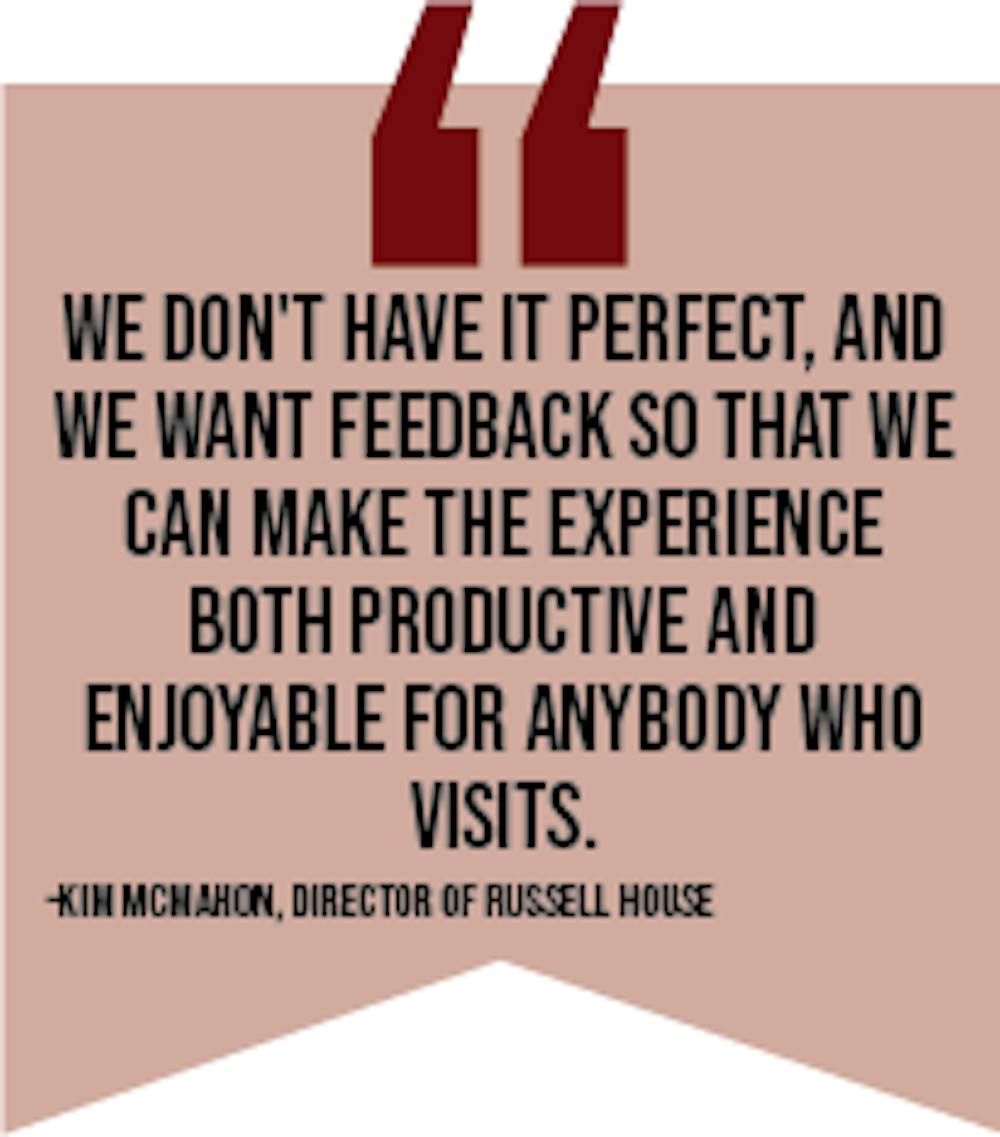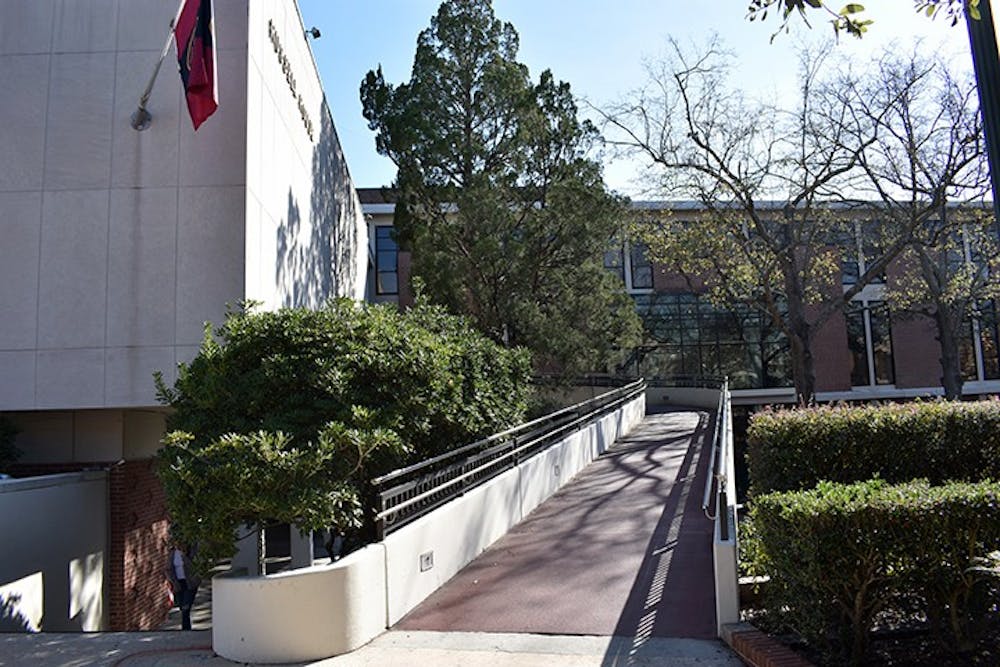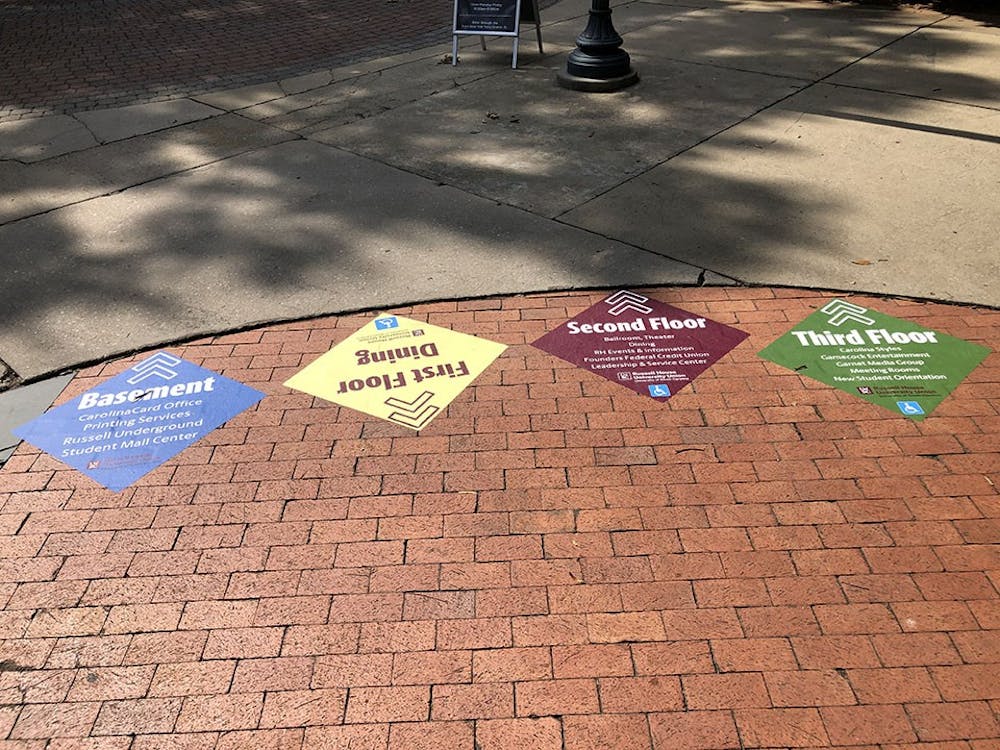As part of its coronavirus prevention procedure, Russell House has implemented a new entrance and exit system to reduce foot traffic in the building.
Russell House now has some doors marked as entrance-only and others as exit-only, with posted signage and color-coded walkways to help control traffic.
"The goal is to limit the swimming upstream; so, the crossing back and forth of students in the various areas of the Russell House, so that we could focus on one-way traffic patterns to keep flow moving smoothly, but also within those safety guidelines of distance," Kim McMahon, director of Russell House, said.
Co-adviser to Delta Alpha Pi, an honor society for students with disabilities, Dow Hammond said he was worried students with cognitive disabilities could be overwhelmed by the traffic flow changes.
"Really, for anybody, not necessarily someone with a disability, I can see how just stepping in there could trigger anxiety," Hammond said. "For some, it would be challenging to absorb all of the instructions and the directions to follow which way to go."
Previously, students could access the bookstore from the inside of Russell House, now the only accessible entrance is on Greene Street. Students with physical disabilities have to go around the bookstore and onto Bull Street to get to the accessible path.
"The path is from a curb-cut at Bull Street, and that is at the bookstore entrance door level," McMahon said. "You'd travel in front of the lower cafe, and then that's how someone with a different ability would bypass the stairs and enter the bookstore."
McMahon said there is signage to help direct people to the bookstore's accessible pathway, but it could be improved.
"We had some temporary signage placed out there at the start of the term, and I think it has lived its shelf life," McMahon said. "We can always improve."
Before making these traffic flow changes to Russell House, McMahon said Russell staff consulted with the Student Disability Resource Center.

"We've been very aware of how important it is to be inclusive and be supportive, and we don't have it perfect, and we want feedback so that we can make the experience both productive and enjoyable for anybody who visits," McMahon said.
When doing an alteration on a building, the Americans with Disabilities Act (ADA) has two requirements, according to an ADA specialist from the Department of Justice's ADA Information Line.
"They have the obligation to make the altered area accessible, and then they also have an obligation to make the path of travel to the altered area accessible," the ADA specialist, who was unable to provide their name, said. "For an existing restaurant, they have an obligation to remove architectural barriers when it's readily achievable to do so, which means easily accomplishable without much difficulty or expense."
The law defines alteration as "changing the usability of an element," according to the specialist.
Russell House was built in the 1950s, with its last major construction occurring in 1976, which qualifies it for safe harbor, a legal protection against liability "if certain conditions are met," according to Cornell's Legal Information Institute.
With the ADA, safe harbor states that any building built prior to the passing of the 2010 ADA is only required to comply with the 1991 ADA regulations. However, any new construction or alterations to a building, regardless of when the building was constructed, have to comply with the updated regulations.
But the new traffic flow changes at Russell might not be subject 2010 ADA since the changes are only temporary due to the coronavirus, the specialist said.
Before these new changes, Russell House already presented architectural challenges to people with physical disabilities because the building was constructed on uneven ground, McMahon said.
McMahon said the "true accessible doors" are through the patio or the entrances under the ramp outside of Panera.
Director of the Student Disability Resource Center Karen Pettus also said the ramps in front of Russell were challenges even before this semester.

"For example, if you're standing facing the Russell House, there is a what I call a flyover. I think it's supposed to be a ramp that takes people up to the second floor, but it's too steep, and so even though it's a ramp, it's not accessible," Pettus said. "If you go to the right there's a brick walkway, and that brick walkway looks like a ramp going down, but again, that ramp is too steep to be considered accessible."
Because of this, Pettus said if someone who is physically disabled was coming from the direction of the bookstore to Russell House, then they would have to go around the building to Davis Field and take a left.
McMahon said, to her knowledge, Russell House is ADA compliant at this time. Pettus said she could not say "Russell is ADA compliant at all," but she also said the staff is "knowledgeable of the issues and the concerns."
Pettus said if any students with disabilities were having issues with the new entrance and exit system at Russell House, they could reach out to her at the Student Disability Resource Center or to McMahon.
"The students have not contacted us, which doesn't mean that they haven't had frustrations, it just means that they haven't contacted us," Pettus said.
Students can contact Russell House at 803-777-3196 and the Student Disability Resource Center at sadrc@mailbox.sc.edu or 803-777-6142.
Editor's note: If you or someone you know has experienced inaccessibility at Russell House or other university buildings, reach out to sagcknews@mailbox.sc.edu.

